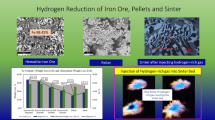Abstract
The focus of this work was to study dissolved oxygen content and oxygen activities in different cast irons. Plant trials were performed on three occasions for lamellar, compacted and nodular iron melts. The results show that at temperatures close to the liquidus temperature the oxygen activities ranged from 0.03 to 0.1 ppm for lamellar graphite iron (LGI), around 0.02 ppm for compacted graphite iron and 0.001 ppm for spheroidal graphite iron. In addition, it was found that as oxygen activities increase with time after an Mg treatment, the ability to form compacted graphite or nodular graphite in Mg-treated iron melts was lowered. Also, oxygen activity differences up to 0.07 ppm were found for different hypoeutectic iron compositions for LGI at the liquidus temperature. Overall, the observed differences in the dissolved oxygen levels are believed to influence how graphite particles are incorporated into the austenite matrix and how the graphite morphology will be in the cast product.








Similar content being viewed by others
References
T. Kusakawa, X. Xu, S. Okimoto, Effects of Oxygen in Cast Iron During Melting and Solidification Process, Report of the castings research laboratory, Waseda University (1988)
F. Mampaey, D. Haberts, F. Seutens, The use of oxygen activity measurement to determine optimal properties of ductile iron during production. Giessereiforschung 60(1), 2–19 (2008)
L. Elmquist, J. Orlenius, A. Diószegi, Influence of melting process on oxygen content in gray iron. AFS Trans. 115, 625–636 (2007)
B. Marincek, in Proceedings of the 2nd International Symposium on the Metallurgy of Cast Iron (Geneva, Switzerland, 1974), pp. 81–95
B. Lux, On the theory of nodular graphite formation in cast iron, parts I and II. AFS Cast Met. Res. J. 6, 49–65 (1972)
R. Källbom, Chunky Graphite in Heavy Section Ductile Iron Castings, Report 16, Chalmers University of Technology, Sweden (2006)
D. Holmgren, A. Dioszegi, I.L. Svensson, Effects of transition from lamellar to compacted graphite on thermal conductivity of cast iron. Int. J. Cast Met. Res. 19(6), 303–313 (2006)
ThermoCalc software ver. 4.01, database TCFE7
Z. Yuzhen, S. Yaowo, L. Yongping, The study of surface-active element oxygen on flow patterns and penetration in A-TIG. Metall. Mater. Trans. B 37B, 485–493 (2006)
G.L. Rivera, R. Boeri, J. Sikora, Searching for a Unified Explanation of the Solidification of Cast Irons, in Proceedings of the Eight International Symposium on Science and Processing of Cast Iron, Beijing, China (2006)
D.M. Stefanescu, Science and Engineering of Casting Solidification, 2nd edn. (Springer Link, New York, 2008)
I.L. Svensson, A. Millberg, A. Diószegi, A study of eutectic inoculation in grey iron by addition of Fe–Si–Ca–Al–, Sr, Ba, Zr, Ti, RE, and C. J. Cast Met. Res. 16, 29–34 (2003)
A. Diószegi, On the Microstructure Formation and Mechanical Properties in Grey Cast Iron, Dissertation 871, Linköping Studies in Science and Technology, Sweden (2004)
H.M. Muhmond, H. Fredriksson, Relationships between the trace elements and graphite growth morphologies in cast iron. Metall. Mater. Trans. A 45A, 6187–6199 (2014)
Acknowledgments
The present work was performed within the frame of IEC/CIC, which is collaboration between Jönköping University, Swerea Swecast, and Swedish foundries. Special thanks are expressed to SKF Mekan AB and Volvo Powertrain AB which hosted the experiments. Furthermore, thanks to Camelia Bondesson and Vasilios Fourlakidis for their assistance during the experimental procedure as well as to Thomas Helander at Sandvik Materials Technology for the calculation of the liquidus temperatures.
Author information
Authors and Affiliations
Corresponding author
Rights and permissions
About this article
Cite this article
Ekengård, J., Diószegi, A. & Jönsson, P.G. A Study of Oxygen Activities Before the Start of Solidification of Cast Irons. Inter Metalcast 10, 500–515 (2016). https://doi.org/10.1007/s40962-016-0067-x
Published:
Issue Date:
DOI: https://doi.org/10.1007/s40962-016-0067-x




